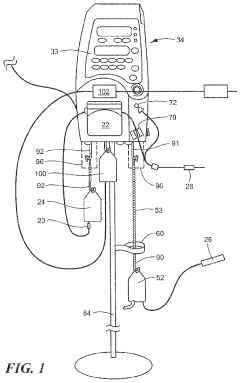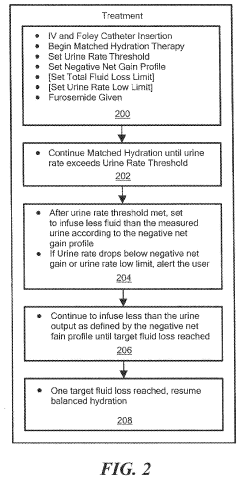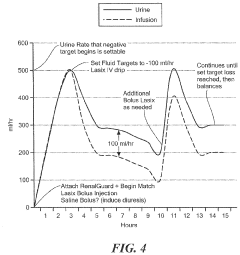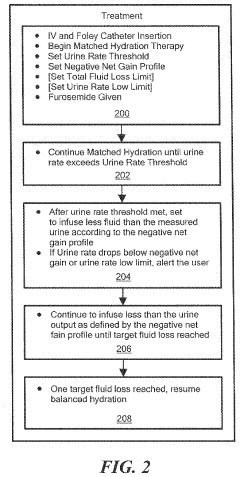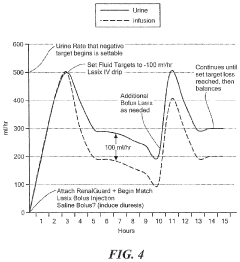Benefits of Hypertonic Saline in Neurological Treatments
Hypertonic Saline Neurological Applications
Hypertonic saline has emerged as a promising treatment option in various neurological conditions, offering significant benefits in managing intracranial pressure and cerebral edema. Its applications span across a wide range of neurological disorders, including traumatic brain injury, stroke, and intracranial hemorrhage.
In the context of traumatic brain injury, hypertonic saline has shown remarkable efficacy in reducing intracranial pressure and improving cerebral perfusion. Studies have demonstrated that it can effectively decrease brain swelling and enhance oxygen delivery to damaged tissues, potentially mitigating secondary brain injury. The osmotic effect of hypertonic saline draws excess fluid from the brain parenchyma into the intravascular space, thereby alleviating cerebral edema.
For stroke patients, hypertonic saline offers a dual benefit. It not only helps in managing cerebral edema but also improves cerebral blood flow. This is particularly crucial in the acute phase of ischemic stroke, where maintaining adequate perfusion to the penumbra can significantly impact patient outcomes. The ability of hypertonic saline to reduce blood viscosity and improve microcirculation further enhances its therapeutic potential in stroke management.
In cases of intracranial hemorrhage, hypertonic saline plays a vital role in controlling intracranial pressure and preventing herniation. Its rapid onset of action makes it an invaluable tool in emergency settings where quick intervention is crucial. Moreover, the sustained effect of hypertonic saline allows for better long-term management of intracranial hypertension compared to other osmotic agents.
The neuroprotective properties of hypertonic saline extend beyond its osmotic effects. Research suggests that it may have anti-inflammatory and immunomodulatory effects, potentially reducing secondary brain injury and improving neurological outcomes. These properties make it a versatile treatment option in various neurological conditions, including subarachnoid hemorrhage and bacterial meningitis.
Another significant advantage of hypertonic saline is its favorable safety profile compared to other osmotic agents like mannitol. It has a lower risk of rebound intracranial hypertension and is less likely to cause electrolyte imbalances or renal complications. This makes hypertonic saline particularly suitable for patients with compromised renal function or those requiring prolonged osmotherapy.
In neurosurgical settings, hypertonic saline has proven beneficial in perioperative management. It helps maintain optimal brain relaxation during surgery, facilitating better surgical access and reducing the need for aggressive brain retraction. This can potentially lead to improved surgical outcomes and reduced postoperative complications.
Market Analysis for Neurological Treatments
The neurological treatment market has been experiencing significant growth in recent years, driven by an increasing prevalence of neurological disorders and a growing aging population. The global market for neurological treatments is expected to reach substantial figures in the coming years, with a compound annual growth rate (CAGR) that outpaces many other healthcare sectors.
Hypertonic saline, as a potential treatment for various neurological conditions, is positioned to capture a notable share of this expanding market. Its applications in managing intracranial pressure, treating cerebral edema, and addressing other neurological issues have garnered increasing attention from healthcare providers and researchers alike.
The demand for hypertonic saline in neurological treatments is primarily fueled by its effectiveness in critical care settings, particularly in cases of traumatic brain injury and stroke. Hospitals and emergency care units represent the largest consumer segment for this treatment, with a growing adoption rate in both developed and developing countries.
Market trends indicate a shift towards more targeted and personalized neurological treatments, which could potentially benefit the use of hypertonic saline. As precision medicine gains traction, the ability to tailor hypertonic saline concentrations and administration protocols to individual patient needs may enhance its market appeal and therapeutic efficacy.
Geographically, North America and Europe currently dominate the market for neurological treatments, including hypertonic saline therapies. However, the Asia-Pacific region is emerging as a rapidly growing market, driven by improving healthcare infrastructure, increasing awareness of neurological disorders, and rising healthcare expenditure.
Challenges in the market include the need for more extensive clinical evidence supporting the long-term benefits of hypertonic saline in various neurological conditions. Additionally, the development of alternative treatments and the potential for side effects in some patient populations may impact market growth.
Despite these challenges, the overall outlook for hypertonic saline in neurological treatments remains positive. The increasing focus on cost-effective treatments that can reduce hospital stay duration and improve patient outcomes aligns well with the benefits offered by hypertonic saline therapy. This positions it favorably in the competitive landscape of neurological treatments.
Current Challenges in Hypertonic Saline Use
Despite the proven benefits of hypertonic saline in neurological treatments, several challenges persist in its clinical application. One of the primary concerns is the optimal concentration and dosage of hypertonic saline. Different studies have reported varying concentrations, ranging from 3% to 23.4%, making it difficult to establish a standardized protocol. This variability can lead to inconsistent outcomes and potential side effects, particularly when higher concentrations are used.
Another significant challenge is the duration and frequency of hypertonic saline administration. There is a lack of consensus on the ideal treatment regimen, with some protocols advocating for continuous infusion while others recommend bolus dosing. This uncertainty can result in suboptimal treatment efficacy and increased risk of adverse events, especially in critically ill patients with complex neurological conditions.
The management of potential side effects poses another hurdle in hypertonic saline use. Rapid changes in serum sodium levels can lead to complications such as central pontine myelinolysis, particularly in patients with chronic hyponatremia. Careful monitoring and adjustment of infusion rates are crucial, but this requires specialized expertise and resources that may not be available in all healthcare settings.
Furthermore, the long-term effects of repeated hypertonic saline administration remain poorly understood. While short-term benefits are well-documented, the impact of prolonged use on brain tissue, electrolyte balance, and overall patient outcomes needs further investigation. This knowledge gap hampers the development of comprehensive treatment strategies for chronic neurological conditions.
Logistical challenges also exist in the preparation and storage of hypertonic saline solutions. Higher concentrations require careful compounding and may not be readily available in pre-mixed formulations. This can lead to preparation errors and potential contamination risks, especially in emergency situations where rapid administration is necessary.
Lastly, the cost-effectiveness of hypertonic saline treatment compared to other osmotic agents, such as mannitol, remains a subject of debate. While hypertonic saline has shown superior efficacy in certain scenarios, its overall economic impact on healthcare systems, particularly in resource-limited settings, requires further evaluation to justify widespread adoption.
Existing Hypertonic Saline Treatment Protocols
01 Medical applications of hypertonic saline
Hypertonic saline solutions are used in various medical applications, including treatment of edema, reducing intracranial pressure, and as a mucolytic agent in respiratory conditions. The high salt concentration helps draw fluid out of tissues and can improve mucus clearance in airways.- Medical applications of hypertonic saline: Hypertonic saline solutions are used in various medical applications, including treatment of edema, reducing intracranial pressure, and managing respiratory conditions. The high salt concentration helps draw excess fluid from tissues and airways, improving patient outcomes in critical care settings.
- Formulation and delivery methods: Different formulations and delivery methods for hypertonic saline are developed to enhance its effectiveness and patient compliance. These include nebulized solutions, nasal sprays, and controlled-release preparations, allowing for targeted and efficient administration of the treatment.
- Combination therapies with hypertonic saline: Hypertonic saline is often combined with other therapeutic agents to enhance its efficacy. These combinations may include antimicrobial agents, mucolytics, or anti-inflammatory compounds, providing synergistic effects in treating various conditions such as cystic fibrosis or chronic sinusitis.
- Diagnostic applications of hypertonic saline: Hypertonic saline solutions are utilized in diagnostic procedures, such as bronchial provocation tests or assessing mucociliary clearance. These applications help in evaluating respiratory function and diagnosing conditions like asthma or primary ciliary dyskinesia.
- Safety and optimization of hypertonic saline use: Research focuses on optimizing the concentration, volume, and frequency of hypertonic saline administration to maximize therapeutic benefits while minimizing potential side effects. Studies also investigate methods to improve patient tolerance and long-term safety of hypertonic saline treatments.
02 Formulation and delivery methods
Different formulations and delivery methods for hypertonic saline are developed to enhance its effectiveness and patient compliance. These include nasal sprays, nebulizers, and controlled-release systems. The concentration and additives in the solution can be optimized for specific therapeutic purposes.Expand Specific Solutions03 Use in wound care and dermatology
Hypertonic saline solutions are employed in wound care and dermatological treatments. They can help in cleansing wounds, reducing bacterial load, and promoting healing. The osmotic effect of hypertonic saline can also be beneficial in managing certain skin conditions.Expand Specific Solutions04 Combination with other therapeutic agents
Hypertonic saline is often combined with other therapeutic agents to enhance its efficacy or provide additional benefits. This may include antimicrobial agents, anti-inflammatory drugs, or other osmotic agents. The combinations are tailored for specific medical conditions or treatment regimens.Expand Specific Solutions05 Industrial and non-medical applications
Beyond medical use, hypertonic saline solutions find applications in various industrial and non-medical fields. These may include use in certain manufacturing processes, environmental remediation, or as a component in specialized cleaning solutions. The high salt concentration can be utilized for its physical and chemical properties in these applications.Expand Specific Solutions
Key Players in Neurological Pharmaceuticals
The use of hypertonic saline in neurological treatments is an emerging field in the early stages of development. The market size is growing, driven by increasing prevalence of neurological disorders and the need for effective treatments. While the technology is still evolving, several key players are advancing research and development. Companies like Xenon Pharmaceuticals, Astellas Pharma, and Takeda Pharmaceutical are investing in clinical trials to explore the potential benefits of hypertonic saline in various neurological conditions. The technology's maturity varies across applications, with some areas showing promising results in preclinical and early clinical stages. As research progresses, collaborations between pharmaceutical companies and academic institutions like the University of Saskatchewan and The Johns Hopkins University are likely to accelerate advancements in this field.
Vertex Pharmaceuticals, Inc.
Medtronic, Inc.
Core Research on Hypertonic Saline Mechanisms
- A fluid management system and method that automatically adjusts hydration fluid delivery based on urine output and clinician settings to achieve a desired urine rate and net fluid loss, using a diuretic and osmotic agents like hypertonic saline to induce diuresis and prevent dehydration.
- A fluid management system and method that automatically adjusts hydration fluid infusion rates based on urine output to achieve a desired urine output rate, followed by controlled fluid loss, using a diuretic and potentially hypertonic saline to prevent dehydration and manage fluid overload.
Regulatory Framework for Neurological Treatments
The regulatory framework for neurological treatments involving hypertonic saline is complex and multifaceted, reflecting the critical nature of these interventions and their potential impact on patient health. In the United States, the Food and Drug Administration (FDA) plays a pivotal role in overseeing the development, approval, and use of hypertonic saline solutions in neurological treatments.
The FDA classifies hypertonic saline solutions as drugs, subjecting them to rigorous testing and approval processes before they can be marketed for neurological applications. This includes extensive clinical trials to demonstrate safety and efficacy, particularly in treating conditions such as cerebral edema and increased intracranial pressure.
Internationally, regulatory bodies such as the European Medicines Agency (EMA) and the World Health Organization (WHO) provide guidelines and standards for the use of hypertonic saline in neurological care. These organizations often collaborate to harmonize regulations and ensure consistent quality and safety standards across different regions.
Healthcare providers must adhere to specific protocols and guidelines when administering hypertonic saline for neurological treatments. These protocols typically include precise dosing instructions, monitoring requirements, and contraindications. Regulatory bodies often require healthcare facilities to implement strict quality control measures and reporting systems for adverse events related to hypertonic saline use.
The regulatory landscape also encompasses manufacturing standards for hypertonic saline solutions. Good Manufacturing Practice (GMP) regulations ensure that these products are consistently produced and controlled according to quality standards appropriate for their intended use.
Research institutions and pharmaceutical companies engaged in developing new applications for hypertonic saline in neurological treatments must navigate a complex regulatory pathway. This includes obtaining approvals for clinical trials, adhering to ethical guidelines for human subject research, and meeting stringent documentation requirements throughout the development process.
Regulatory bodies also monitor post-market surveillance of hypertonic saline use in neurological treatments. This ongoing process helps identify any long-term safety concerns or previously unrecognized adverse effects, allowing for timely updates to usage guidelines and safety information.
As the field of neurology advances, regulatory frameworks continue to evolve to address emerging technologies and treatment modalities. This includes considerations for personalized medicine approaches and the integration of hypertonic saline treatments with other neurological interventions.
Cost-Benefit Analysis of Hypertonic Saline Therapy
The cost-benefit analysis of hypertonic saline therapy in neurological treatments reveals a complex interplay of economic factors and clinical outcomes. From a financial perspective, the implementation of hypertonic saline therapy requires minimal additional infrastructure in most hospital settings, as the solution is readily available and can be administered through existing intravenous lines. This low barrier to entry contributes to its cost-effectiveness, particularly when compared to more invasive or technologically demanding interventions.
The primary economic benefit of hypertonic saline therapy lies in its potential to reduce the length of hospital stays and decrease the need for more expensive interventions. By effectively managing intracranial pressure and cerebral edema, hypertonic saline can potentially accelerate patient recovery, leading to earlier discharges and reduced overall healthcare costs. Additionally, its use may prevent the progression of neurological conditions to more severe states, thereby avoiding the substantial costs associated with intensive care and long-term rehabilitation.
However, the cost analysis must also consider the potential for adverse effects and their associated treatment costs. While generally well-tolerated, hypertonic saline therapy can lead to complications such as electrolyte imbalances, which may require additional medical management and monitoring. These potential complications, though relatively rare, should be factored into the overall cost assessment.
From a clinical benefit standpoint, hypertonic saline therapy has demonstrated significant advantages in various neurological conditions. Its efficacy in reducing intracranial pressure and improving cerebral perfusion can lead to better neurological outcomes, potentially reducing long-term disability and improving quality of life for patients. This improvement in patient outcomes not only represents a significant clinical benefit but also translates to economic advantages in terms of reduced long-term care costs and increased productivity of recovered patients.
The cost-benefit ratio is further enhanced by the versatility of hypertonic saline therapy. Its applicability across a range of neurological conditions, from traumatic brain injury to ischemic stroke, means that hospitals can leverage a single intervention for multiple patient populations, potentially leading to economies of scale in procurement and administration.
In conclusion, the cost-benefit analysis of hypertonic saline therapy in neurological treatments generally favors its implementation. The relatively low cost of the intervention, combined with its potential to improve patient outcomes and reduce overall healthcare expenditure, positions it as an economically viable and clinically beneficial treatment option. However, ongoing research and real-world data collection are essential to further refine this analysis and optimize the use of hypertonic saline therapy in various clinical scenarios.
